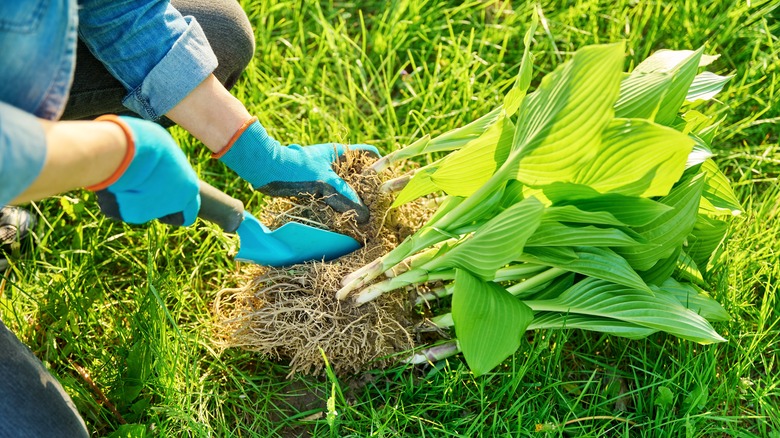Perennial plants like hostas are known for their appealing foliage and low maintenance needs. However, occasionally, youll need to get rid of these plants in your garden. There are various ways to accomplish this. If you prefer a more hands-on method, you can choose to pull them by hand. Chemical solutions like weed killers and more natural approaches like vinegar are also options.
While hosta plants can add lush foliage and a touch of elegance to shady areas in your garden, there are several compelling reasons you might want to remove them. Hostas are known to attract various pests, from slugs and snails to deer, which could then move on to feast on other, more vulnerable plants in your garden. And though not invasive, they are fast-growing and can take up more space than you initially allocated, thereby throwing off your gardens overall design.
Additionally, if youre thinking of giving your garden a makeover, hostas could prove to be an obstacle. Their preference for shade might conflict with your plans to introduce plants that require full sun exposure. Finally, lets not forget that gardening styles and preferences change over time; what seemed like the perfect plant choice years ago may not align with your current vision for your outdoor space. For these reasons and more, pulling hostas out is the best option.
Hostas are popular landscaping plants, prized for their attractive foliage and ability to thrive in shade But sometimes, you need to get rid of hostas in your yard Maybe they’ve become diseased, overgrown their space, or just don’t fit your plans anymore. Whatever the reason, eliminating hostas completely can be tricky. But with the right techniques, you can kill hostas successfully so they don’t regrow.
Why Remove Hostas from Your Yard?
There are several common reasons for killing off hostas:
-
They’ve grown too large and crowded out other plants. Hostas spread aggressively through rhizomes under the soil
-
You’re renovating your garden and need to clear space.
-
You want to plant sun-loving flowers and vegetables instead. Hostas require shade.
-
The broad hosta leaves attract slugs and snails which can spread to other plants
-
Deer are drawn to the foliage and can quickly defoliate the hostas.
-
You simply want a change from hostas. Gardening plans and tastes evolve over time.
Challenges in Removing Hostas Permanently
Mature hostas can be persistent weeds after removal because:
-
Their extensive root systems allow regrowth if not fully extracted.
-
The waxy leaves repel water-based herbicides. Chemicals don’t absorb well.
-
They can regrow from tiny leftover pieces of root and crown tissue.
-
Large leaves require thorough herbicide contact for effectiveness.
-
Hostas thrive in shade so solarization is less successful.
Completely killing off hostas takes determination and diligence to overcome these challenges.
Effective Methods to Kill Hostas
Hand Digging
Manually digging up hostas is labor intensive but avoids chemicals.
-
Loosen soil with shovel or spade first to make pulling easier.
-
Grip at base of plant and pull straight up to extract roots.
-
Check for and remove any remaining roots to prevent regrowth.
-
Best for small hostas. Large plants likely leave remnants that may resprout.
Smothering With Mulch
Covering hostas deprives them of light and oxygen.
-
Cut back any flower stalks so there’s less to cover.
-
Cover area 3-4 inches deep with mulch like wood chips or compost.
-
Leave covered for a full year. Check for and remove new growth.
-
Avoid chemicals but slower. Best for small areas.
Solarization
Solarizing uses sunlight to overheat and kill plants.
-
Mow down foliage so black plastic makes soil contact.
-
Cover area completely with clear plastic sheeting for full summer.
-
Seal edges well with soil or rocks. Prevent light getting in.
-
Less effective on shade loving hostas. May need a second year.
Herbicides
Chemical weed killers like glyphosate work quickly but with risks.
-
Use extreme caution and follow all label instructions.
-
Spray thoroughly to wet all foliage. Use coarse nozzle.
-
Reapply as needed when any regrowth appears.
-
Dispose of dead plants properly when fully killed.
Burning
Flame weeding scorches hostas away for good.
-
Remove any dead leaves or debris before burning.
-
Pre-wet soil first as a critical fire safety precaution.
-
Run flame across leaves and crown until fully wilted and burnt.
-
Persist with repeated burning as any new shoots emerge.
-
Use extreme care to prevent uncontrolled fire with burning.
Vinegar
Household vinegar makes a natural DIY herbicide.
-
Use 20% acetic acid white vinegar full strength.
-
Coat all foliage thoroughly with vinegar solution.
-
The acid draws moisture out, killing the plant.
-
Repeat applications may be needed as regrowth appears.
-
Safer than chemicals but slower. May need other methods.
After Killing Hostas, Prevent Regrowth
To stop hostas from returning after removal:
-
Remove every root trace when extracting plants. Dig deep.
-
Monitor area for any new sprouts. Remove immediately.
-
Install landscape fabric or weed barrier covered with mulch.
-
Plant competitive cover crops and spreading perennials.
-
Stay vigilant with frequent checks for any hosta regrowth.
Killing off unwanted hostas completely calls for persistence over time. But using the right techniques repeatedly, you can eliminate them for good. Enjoy your new hosta-free landscape!

Natural methods: pulling by hand and using vinegar

Pulling hostas by hand is your first and most straightforward option for getting rid of them. To facilitate this task, start by watering the soil to make it more pliable. Once the ground is adequately moist, use a spade or a shovel to gently loosen the soil surrounding the hosta. With a firm grip at the base of the plant, pull it out, removing as much of the root system as possible to prevent future regrowth. This method is most effective and easiest when the hostas are relatively small and the soil is moist, as drier soil can make it difficult to extract the entire root system.
If manual labor isnt your thing, or you want to steer clear of chemicals, consider the boiling water method. Boiling water weakens the plant almost instantly upon contact. Pour it carefully over the hostas, targeting the base of each plant to maximize impact. This technique is particularly effective on smaller, less established hostas. To ensure your safety, always remember to wear protective gloves and long sleeves to minimize the risk of burns or other injuries. Lastly, another effective herbicide is vinegar. Fill a spray bottle with undiluted white vinegar and coat the hosta leaves generously. Its best to carry out this operation on a sunny day; the natural heat from the sun coupled with the acidic vinegar accelerates the plants demise.
How to Kill Hostas
FAQ
How do I get rid of hostas permanently?
Opt for a systemic herbicide like glyphosate; the leaves of the hostas will absorb this chemical and transfer it down to the roots, thereby killing the entire plant. It’s important to follow the manufacturer’s instructions meticulously for optimal results.
Will bleach kill hosta plants?
In your own backyard Clorox™ Disinfecting Bleach is great for maintenance, and will not harm your grass or plants when used as directed.
Will baking soda kill my hostas?
I agree completely. There may be a good reason they’re there. If and when you find out and still want to remove them, you can dust the hostas with baking soda, especially the leaves and stems. Reapply until they’re gone.
What stops hostas from being eaten?
Physical barriers, such as coarse grit, pulverised seashells, crushed eggshells, diatomaceous earth, coffee grounds, and wool pellets, can all be used to keep …
How do you kill a hosta plant?
Plain white vinegar makes a DIY natural herbicide: Fill a spray bottle with undiluted household white vinegar. On a sunny day, thoroughly coat hosta leaves, crown, and stems with vinegar. The acidity of the vinegar draws moisture out and dessicates the plant. Repeat weekly until the hosta is fully dead. Vinegar is non-toxic and won’t harm soil.
Should you get rid of Hosta plants?
There are many good reasons to get rid of hosta plants, even though they can add lush foliage and a touch of elegance to shady parts of your garden. Pests like slugs, snails, and even deer are known to come to hostas. These animals may then eat other, weaker plants in your garden.
Do weed killers kill hostas?
In this case, chemical weed killers can offer a quick and effective solution. Opt for a systemic herbicide like glyphosate; the leaves of the hostas will absorb this chemical and transfer it down to the roots, thereby killing the entire plant. It’s important to follow the manufacturer’s instructions meticulously for optimal results.
What happens if you have too many Hostas in a garden?
Lack of diversity: While hostas are popular for their lush foliage and ability to tolerate shade, having too many hostas in a garden can result in a lack of plant diversity. This can make the garden less visually interesting and limit the range of habitats for other plants and wildlife.
How do you remove hostas from a garden?
Consider using a sharp shovel or garden fork to help loosen the soil around the plants. Once removed, you will need to dispose of the hostas properly, either by composting them or discarding them in yard waste bags. Replacing the hostas: After removing the hostas, you will need to decide what to do with the empty space.
Does hot water kill hostas?
The hot water will scald the leaves and kill the plant. Hostas are easy to plant and easy to care for. These hardy plants can be planted in sun and shade, need little attention and come back year after year, usually looking better than they did the season before. For this same reason, it is sometimes difficult to kill hosta.
